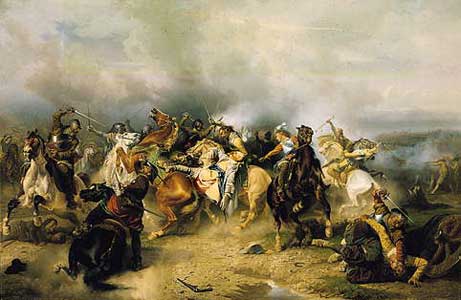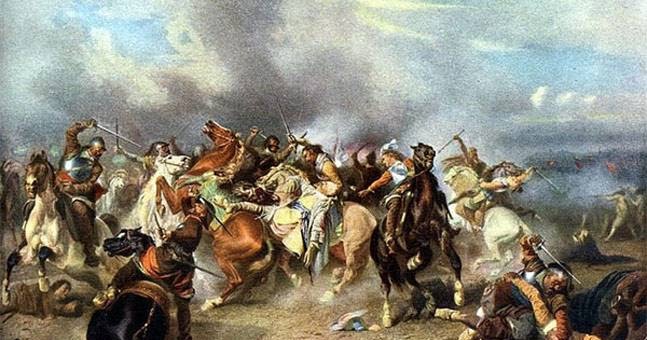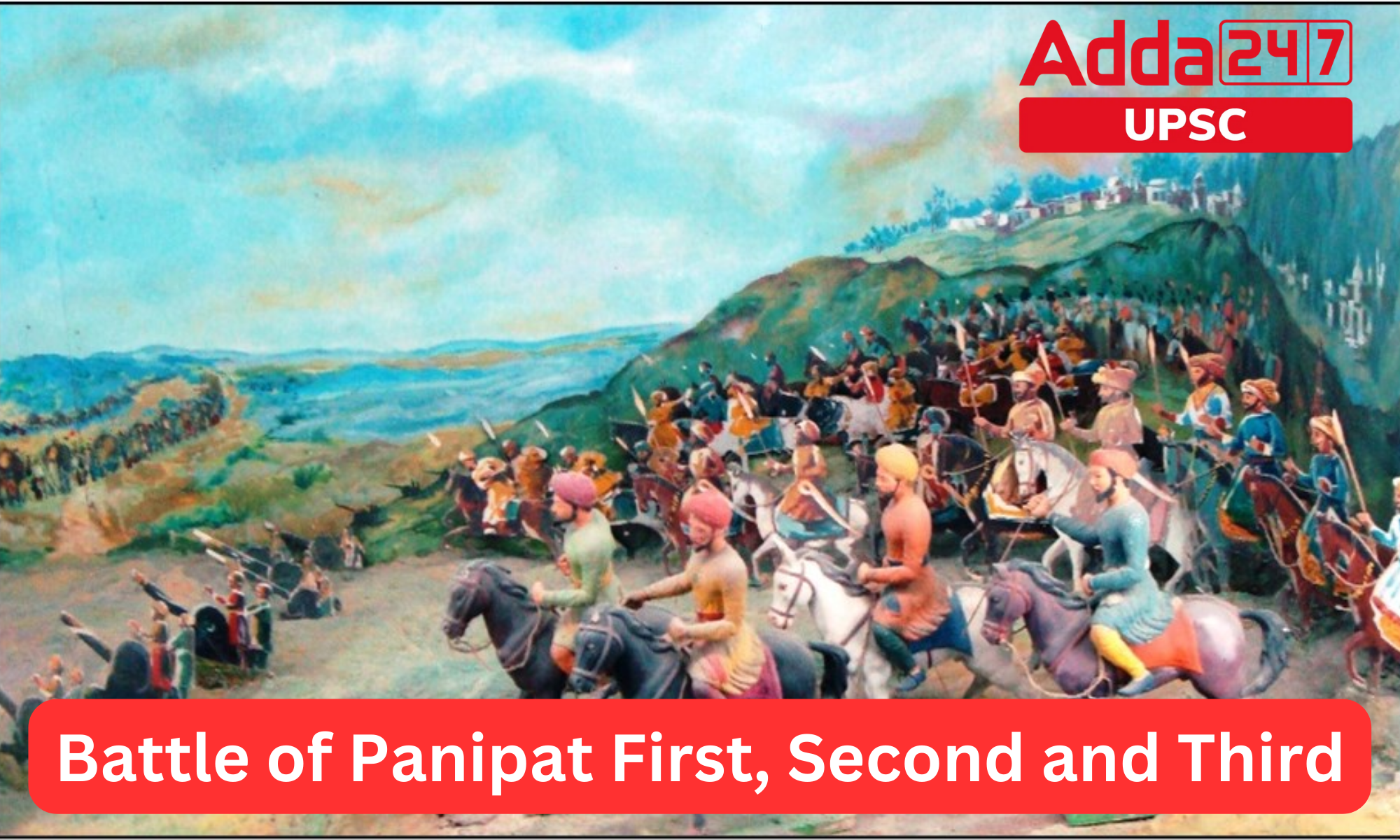Table of Contents
Battle of Panipat
The Battles of Panipat are some of the most significant and well-known battles in Indian history. There were three major battles fought in Panipat, a city in the northern Indian state of Haryana, during the 16th and 18th centuries. Each of these battles was fought between the forces of two powerful empires that were vying for control of the Indian subcontinent. These battles were some of the bloodiest and most decisive in Indian history, and their impact on the subcontinent’s political landscape cannot be overstated. This topic is important for UPSC Civil service Examaminaton and others State PCS examination.
Battle of Panipat in Short
Below are the Battle of Panipat first, second and third in detail:
The First Battle of Panipat in Short
- The first battle of Panipat was fought on April 21, 1526, between the forces of the Mughal Empire, led by Babur, and the forces of the Delhi Sultanate, led by Ibrahim Lodi.
- The Mughals were a relatively new force in India at the time, having only recently established themselves in Kabul, Afghanistan.
- The Delhi Sultanate, on the other hand, was an established power that had ruled over northern India for centuries.
- The battle was a decisive victory for Babur, who used superior tactics and technology to defeat Ibrahim Lodi’s much larger army. Babur’s use of artillery and muskets gave him a significant advantage over the Sultanate’s traditional cavalry-based army.
- The battle lasted only a few hours, and the Delhi Sultanate suffered heavy losses.
- Ibrahim Lodi himself was killed in the battle, marking the end of the Sultanate and the beginning of Mughal rule in India.

The Second Battle of Panipat in Short
- The second battle of Panipat was fought on November 5, 1556, between the forces of the Mughal Empire, led by Akbar, and the forces of Hemu, a Hindu king who had risen to power in northern India.
- Hemu had defeated the Mughal army in several previous battles and was seen as a significant threat to Mughal rule.
- The battle was a closely fought affair, with both sides suffering heavy casualties.
- However, in the end, Akbar’s superior tactics and leadership prevailed, and Hemu was defeated.
- Hemu himself was captured and executed, marking the end of his short-lived reign.

The Third Battle of Panipat in Short
- The third battle of Panipat was fought on January 14, 1761, between the forces of the Maratha Empire, led by Sadashivrao Bhau, and the forces of the Durrani Empire, led by Ahmad Shah Durrani.
- The Marathas were a powerful Hindu empire that had emerged in western India and had been expanding their territory for several decades.
- The Durrani Empire, on the other hand, was an Afghan empire that had been expanding into India from the northwest.
- The battle was one of the bloodiest in Indian history, with estimates of the casualties ranging from 60,000 to 100,000.
- The Marathas suffered a crushing defeat, with their entire army being destroyed or captured.
- The defeat marked the end of Maratha expansion and the beginning of a period of Durrani dominance in northern India.

Conclusion
The Battles of Panipat were some of the most significant and influential battles in Indian history. Each battle marked a turning point in the subcontinent’s political landscape and had far-reaching consequences for the region’s history. The battles were characterized by their brutality and scale, with huge armies clashing in epic battles that determined the fate of empires. Today, the battles are remembered as key events in Indian history and serve as a reminder of the importance of military strategy, leadership, and technology in shaping the course of history.
Battle of Panipat in Detail:
Below are the Battle of Panipat first, second and third in detail:
The First Battle of Panipat
The First Battle of Panipat was a significant battle fought between the forces of the Mughal Emperor Babur and the Lodi Empire on April 21, 1526. This battle is considered to be one of the most important battles in Indian history, as it marked the beginning of Mughal rule in India and the end of the Delhi Sultanate.
First Battle of Panipat: Background
Before the battle, the Lodi Empire was ruling over most parts of North India, including Delhi. Babur, who was the ruler of the Timurid Empire in Central Asia, decided to invade India in order to expand his kingdom. He landed in India with a force of around 12,000 soldiers and marched towards Delhi.
The Lodi Empire, under the leadership of Sultan Ibrahim Lodi, gathered a force of around 100,000 soldiers to defend their empire. The two armies met at Panipat, a town in present-day Haryana.
First Battle of Panipat: The Battle
- The battle began with a fierce charge by the Lodi cavalry, which initially succeeded in breaking through the Mughal lines.
- However, Babur quickly rallied his troops and managed to hold off the Lodi attack.
- Babur then ordered his soldiers to launch a counter-attack, which caught the Lodi army off guard.
- The Mughal army, which was smaller in size, was able to defeat the Lodi army through superior tactics and firepower.
- The Lodi army suffered heavy losses, including their leader, Sultan Ibrahim Lodi, who was killed in the battle.
The victory at the First Battle of Panipat gave Babur control over Delhi and paved the way for the Mughal Empire to establish itself in India. Babur went on to conquer other parts of North India, including Agra, which became the capital of the Mughal Empire.
First Battle of Panipat: Aftermath
The battle was significant not only for its immediate outcome but also for its long-term impact on Indian history. The Mughal Empire, which was established after the battle, ruled over India for more than three centuries and left a lasting impact on Indian culture and society.
First Battle of Panipat: Conclusion
The First Battle of Panipat was a pivotal moment in Indian history. It marked the beginning of Mughal rule in India and the end of the Delhi Sultanate. The battle was won through superior tactics and firepower, and its impact was felt for centuries to come. Today, it is remembered as one of the most important battles in Indian history.

The Second Battle of Panipat
The Second Battle of Panipat was fought on November 5, 1556, between the forces of the Mughal Empire led by Akbar, the grandson of Babur, and the combined forces of the Hindu king Hemu and his Rajput allies. The battle was one of the most significant and bloodiest battles fought in Indian history, with over 100,000 soldiers on both sides.
Second Battle of Panipat: Background
After the death of Babur, his son Humayun ascended to the Mughal throne. However, his reign was marked by a series of defeats and he was ultimately ousted by Sher Shah Suri. Humayun spent the next 15 years in exile, trying to regain his lost empire. In 1555, he succeeded in recapturing Delhi from the Sur dynasty and was once again crowned as the emperor of the Mughal Empire.
However, Hemu, a Hindu king from the northwestern Indian region of Haryana, saw this as an opportunity to establish his own empire. Hemu had successfully captured Delhi from the Sur dynasty and had declared himself as the ruler of India. He had the support of the Rajputs, who saw him as a champion of Hinduism.
Second Battle of Panipat: The Battle
- The Mughal army, led by Akbar and his regent Bairam Khan, marched towards Delhi to confront Hemu’s army.
- The two armies met near the town of Panipat.
- Hemu’s army was well-equipped with cannons and elephants, which were a significant advantage on the battlefield.
- On the other hand, the Mughal army was primarily composed of cavalry.
- The battle started with a skirmish between the two armies, which soon turned into a full-blown battle.
- Hemu’s forces initially had the upper hand, and Hemu himself rode an elephant into the battlefield to rally his troops.
- However, in a turn of events, Hemu was hit by an arrow in the eye and fell unconscious.
- This led to confusion in his ranks, and the Mughals took advantage of this to launch a fierce counter-attack.
The Mughal cavalry charged into Hemu’s disoriented troops, and the battle quickly turned into a massacre. Hemu’s army was completely defeated, and many of his troops were killed or captured. Hemu himself was captured and brought before Akbar. Bairam Khan wanted to execute Hemu on the spot, but Akbar showed clemency and ordered that Hemu be taken to Delhi and publicly executed.
Second Battle of Panipat: Aftermath
The Second Battle of Panipat was a significant turning point in Indian history. It marked the end of the Sur dynasty and established the Mughal Empire as the dominant power in India. The victory also cemented Akbar’s position as the emperor of the Mughal Empire and paved the way for his successful reign.
The battle was also significant in terms of military tactics. The use of cannons and elephants on the battlefield was a significant innovation that gave Hemu’s army an initial advantage. However, the Mughals adapted quickly and used their superior cavalry to turn the tide of the battle.
Second Battle of Panipat: Conclusion
The Second Battle of Panipat was one of the bloodiest battles fought in Indian history. It marked the end of one dynasty and the rise of another. The battle was significant in terms of military tactics and innovation and established the Mughal Empire as the dominant power in India for centuries to come.
The Third Battle of Panipat
The Third Battle of Panipat is considered to be one of the largest and bloodiest battles fought in Indian history. This historic battle was fought on 14 January 1761 between the Maratha Empire and the Durrani Empire (Afghanistan). The battle was fought in Panipat, which is located in present-day Haryana, India. The outcome of the battle had a significant impact on the political and cultural landscape of India, particularly in the north.
Third Battle of Panipat: Background
The Maratha Empire was the dominant power in India during the mid-18th century. The Marathas had been expanding their empire in northern India, and by 1758 they had control over Delhi and most of the surrounding areas. Ahmad Shah Durrani, also known as Ahmad Shah Abdali, was the ruler of Afghanistan and had previously been defeated by the Marathas in the Battle of Kunjpura in 1758.
The Marathas were led by Sadashivrao Bhau, who was the cousin of the Peshwa (the chief minister of the Maratha Empire). On the other hand, the Durrani Empire was led by Ahmad Shah Durrani himself. The battle was fought between the two armies in the open fields of Panipat.
Third Battle of Panipat: The Battle
- The battle began on 14 January 1761, with the Marathas numbering around 100,000 soldiers, while the Durrani Empire had approximately 75,000 soldiers.
- The Maratha army was composed of soldiers from different parts of India, including Rajputs, Sikhs, and Jats, among others.
- The Durrani army, on the other hand, was primarily composed of Afghan soldiers.
- The Maratha army attacked the Durrani army head-on, and the two armies clashed in a fierce battle that lasted for several hours.
- The Maratha army initially had the upper hand, and they managed to push the Durrani army back.
- However, the tide of the battle turned when the Maratha army’s left flank was attacked by the Durrani army’s cavalry.
The Maratha army was taken by surprise and was unable to counter the attack. This allowed the Durrani army to flank the Marathas, which ultimately led to their defeat. The Maratha army suffered heavy losses, with approximately 100,000 soldiers killed or captured, while the Durrani army suffered around 20,000 casualties.
Third Battle of Panipat: Impact
The Third Battle of Panipat had a significant impact on the political and cultural landscape of India. The Maratha Empire was severely weakened after the battle, and their dominance in northern India came to an end. The British East India Company, who were expanding their control in India, also took advantage of the Maratha’s weakened state and gained more control over India.
The battle also had a cultural impact, as it marked the end of the era of Mughal Empire in India, which had been in decline since the 18th century. The Marathas were seen as the successors to the Mughal Empire, and their defeat marked the end of the indigenous Indian power in northern India.
Third Battle of Panipat: Conclusion
The Third Battle of Panipat was a significant event in Indian history. It was a turning point in the political and cultural landscape of India, and its impact is still felt today. The battle was a brutal and bloody affair, and it serves as a reminder of the price of power and the cost of war.
Question asked on The Battles of Panipat
1. During which of the following war Artillery was used by one side? UPPCS (Pre) G.S. 1996
(a) First battle of Panipat
(b) Battle of Khanua
(c) Battle of Plassey
(d) Third battle of Panipat
Ans- (a) First battle of Panipat
2. What was the main cause behind the victory of Babur in the battle of Panipat ? BPSC (Pre) 1994
(a) His cavalry army
(b) His military efficiency
(c) Tulugama strategy
(d) Internal conflict of Afghans
Ans-(b) His military efficiency
3. Between whom the third war of Panipat was fought in 1761?
(a) British and Maratha
(b) British and French
(c) Ahmad Shah Abdali and Marathas
(d) Shivaji and Shaista Khan
Ans- (c) Ahmad Shah Abdali and Marathas
| Also Read: | |




 TSPSC Group 1 Question Paper 2024, Downl...
TSPSC Group 1 Question Paper 2024, Downl...
 TSPSC Group 1 Answer key 2024 Out, Downl...
TSPSC Group 1 Answer key 2024 Out, Downl...
 UPSC Prelims 2024 Question Paper, Downlo...
UPSC Prelims 2024 Question Paper, Downlo...





